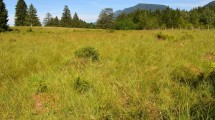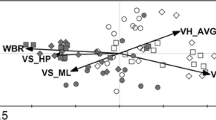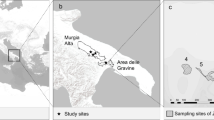Abstract
The decline in semi-natural habitat is posing a threat to several grassland insect species, including the silver-studded blue butterfly, Plebejus subsolanus ssp. iburiensis, which is listed as a “nationally rare species of wild fauna in Japan”. We investigated the effects of mowing on the larvae and adults stages of P. subsolanus in the same population in a conservation area, aiming to identify effective habitat management for this species and all coexisting butterflies. We surveyed the number P. subsolanus larvae and adults, host plant characteristics, butterfly abundance, species richness, and flowering plant metrics in both mowed and unmowed areas. Larvae only appeared in the mowed area, and the cover and height of host plant were significantly higher in the mowed area. P. subsolanus adults and butterfly abundance were higher in the mowed area. No statistical differences were observed in the butterfly species richness, inflorescences and species numbers of flowering plants, or the vegetation height between the mowed and unmowed areas. Mowing has a positive effect on P. subsolanus larvae and adults, while it has a limited effect on reducing vegetation height. The negative correlation with butterfly species richness, flowering plant species, and inflorescences underscores the need to maintain optimal vegetation height in these areas, to control excessive vegetation growth.
Implications for insect conservation
Our results show that mowing conducted concurrently with the pupal stage and egg stage could be effective in the conservation management of butterfly and floral communities, including P. subsolanus and its host plants.





Similar content being viewed by others
Data availability
The data used in this study are available from the authors on request.
References
Brys R, Jacquemyn H, Endels P, Blust GD, Hermy M (2004) The effects of grassland management on plant performance and demography in the perennial herb Primula veris: Plant performance and demography of a grassland herb. J Appl Ecol 41:1080–1091. https://doi.org/10.1111/j.0021-8901.2004.00981.x
Colom P, Traveset A, Stefanescu C (2021) Long-term effects of abandonment and restoration of Mediterranean meadows on butterfly-plant interactions. J Insect Conserv 25:383–393. https://doi.org/10.1007/s10841-021-00307-w
Endels P, Jacquemyn H, Brys R, Hermy M (2007) Reinstatement of traditional mowing regimes counteracts population senescence in the rare perennial Primula vulgaris. Appl Veg Sci 10:351–360. https://doi.org/10.1111/j.1654-109X.2007.tb00434.x
Endress BA, Averett JP, Steinmetz S, Quaempts EJ (2022) Forgotten forbs: Standard vegetation surveys underrepresent ecologically and culturally important forbs in a threatened grassland ecosystem. Conserv Sci Pract 4:e12813. https://doi.org/10.1111/csp2.12813
Hayamizu M, Iwasaki K, Nitta N, Nakahama N (2020) Endangered wild fauna and flora in shelterbelts of Hokkaido: The relationship between habitat and shelterbelt management. Koshunai-Kihou 194:11–16
Henwood WD (2010) Toward a strategy for the conservation and protection of the world’s temperate grasslands. Gr Plains Res 20:121–134
Huhta A, Rautio P, Tuomi J, Laine K (2001) Restorative mowing on an abandoned semi-natural meadow: short-term and predicted long-term effects. J Veg Sci 12:677–686. https://doi.org/10.2307/3236908
Humbert JY, Ghazoul J, Sauter GJ, Walter T (2010) Impact of different meadow mowing techniques on field invertebrates. J Appl Entom 134:592–599. https://doi.org/10.1111/j.1439-0418.2009.01503.x
Inoue M, Nakagoshi N (2001) The effects of human impact on spatial structure of the riparian vegetation along the Ashida river, Japan. Landsc Urban Plan 53:111–121. https://doi.org/10.1016/S0169-2046(00)00145-6
Johst K, Drechsler M, Thomas J, Settele J (2006) Influence of mowing on the persistence of two endangered large blue butterfly species. J Appl Ecol 43:333–342. https://doi.org/10.1111/j.1365-2664.2006.01125.x
Joubert-van der Merwe L, Pryke JS, Samways MJ (2019) Well-managed grassland heterogeneity promotes butterfly conservation in a corridor network. J Env Manage 238:382–395. https://doi.org/10.1016/j.jenvman.2019.03.021
Konvicka M, Benes J, Cizek O, Kopecek F, Konvicka O, Vitaz L (2008) How too much care kills species: grassland reserves, agri-environmental schemes and extinction of Colias myrmidone (Lepidoptera: Pieridae) from its former stronghold. J Ins Conserv 12:519–525. https://doi.org/10.1007/s10841-007-9092-7
Konvicka M, Hula V, Vlasanek P, Zimmermann K, Faltynek Fric Z (2023) Within-habitat vegetation structure and adult activity patterns of the declining butterfly Euphydryas Aurinia. J Insect Conserv 27:335–346. https://doi.org/10.1007/s10841-023-00459-x
Ministry of the Environment, Government of Japan (2020) The Red List of insects of Japan. https://www.env.go.jp/press/107905.html. Accessed 31 Jan 2022
Ministry of the Environment, Government of Japan (2023) The list of the nationally endangered species of wild fauna and flora. http://www.env.go.jp/nature/kisho/domestic/list.html. Accessed 1 Apr 2023
Nagamori T, Nagamori H, Shibata T et al (2016) The complete guide to butterflies of Hokkaido. Hokkaido University Press, Sapporo
Nagata YK, Ushimaru A (2016) Traditional burning and mowing practices support high grassland plant diversity by providing intermediate levels of vegetation height and soil pH. Appl Veg Sci 19:567–577. https://doi.org/10.1111/avsc.12252
Nakahama N, Hayamizu M, Iwasaki K, Nitta N (2022) Management and landscape of shelterbelts contribute to butterfly and flowering plant diversity in northern Japan. Ecol Res 37:780–790. https://doi.org/10.1111/1440-1703.12342
Nakahama N, Uchida K, Ushimaru A, Isagi Y (2016) Timing of mowing influences genetic diversity and reproductive success in endangered semi-natural grassland plants. Agric Ecosyst Environ 221:20–27. https://doi.org/10.1016/j.agee.2016.01.029
Nakahama N, Uchida K, Ushimaru A, Isagi Y (2018) Historical changes in grassland area determined the demography of semi-natural grassland butterflies in Japan. Heredity 121:155–168. https://doi.org/10.1038/s41437-018-0057-2
Noda A, Kondoh A, Nishihiro J (2019) Changes in land cover and grassland area over the past 120 years in a rapidly urbanised area in Japan. OE 4:e37669. https://doi.org/10.3897/oneeco.4.e37669
Nunez S, Alkemade R, Kok K, Leemans R (2020) Potential biodiversity change in Central Asian grasslands: Scenarios for the impact of climate and land-use change. Reg Environ Change 20:39. https://doi.org/10.1007/s10113-020-01619-4
Ohwaki A (2018) How should we view temperate semi-natural grasslands? Insights from butterflies in Japan. Glob Ecol Conserv 16:e00482. https://doi.org/10.1016/j.gecco.2018.e00482
Ohwaki A (2019) Entire-area spring burning versus abandonment in grasslands: Butterfly responses associated with hibernating traits. J Insect Conserv 23:857–871. https://doi.org/10.1007/s10841-019-00181-7
Oki K, Soga M, Amano T, Koike S (2022) Abandonment of ski pistes impoverishes butterfly communities. Biodivers Conserv 31:2083–2096. https://doi.org/10.1007/s10531-022-02422-9
Pollard E, Yates TJ (1993) Monitoring butterflies for ecology and conservation. Springer Science & Business Media, London
R Core Team (2023) R. R: A Language and Environment for Statistical Computing, version 4.2.2. http://www.R-project. org. Vienna
Roux-Fouillet P, Wipf S, Rixen C (2011) Long-term impacts of ski piste management on alpine vegetation and soils. J Appl Ecol 48:906–915. https://doi.org/10.1111/j.1365-2664.2011.01964.x
Shirouzu T (2006) The butterflies of Japan in color. Gakken, Tokyo
Tälle M, Deák B, Poschlod P, Valkó O, Westerberg L, Milberg P (2016) Grazing vs. mowing: A meta-analysis of biodiversity benefits for grassland management. Agric Ecosyst Environ 222:200–212. https://doi.org/10.1016/j.agee.2016.02.008
Tsuyuzaki S (1995) Ski slope vegetation in central Honshu, Japan. Environ Manage 19:773–777. https://doi.org/10.1007/BF02471959
Ubach A, Páramo F, Gutiérrez C, Stefanescu C (2020) Vegetation encroachment drives changes in the composition of butterfly assemblages and species loss in Mediterranean ecosystems. Insect Conserv Divers 13:151–161. https://doi.org/10.1111/icad.12397
Uchida K, Ushimaru A (2014) Biodiversity declines due to abandonment and intensification of agricultural lands: Patterns and mechanisms. Ecol Monogr 84:637–658. https://doi.org/10.1890/13-2170.1
Ushimaru A, Uchida K, Suka T (2018) Grassland biodiversity in Japan: Threats, management and conservation. In: Grasslands of the world. CRC Press, Boca Raton
Warren MS, Maes D, van Swaay CA et al (2021) The decline of butterflies in Europe: problems, significance, and possible solutions. Proc Natl Acad Sci U S A 118:e2002551117. https://doi.org/10.1073/pnas.2002551117
Wintergerst J, Kästner T, Bartel M, Schmidt C, Nuss M (2021) Partial mowing of urban lawns supports higher abundances and diversities of insects. J Insect Conserv 25:797–808. https://doi.org/10.1007/s10841-021-00331-w
Wright CK, Wimberly MC (2013) Recent land use change in the Western Corn Belt threatens grasslands and wetlands. Proc Natl Acad Sci U S A 110:4134–4139. https://doi.org/10.1073/pnas.1215404110
Wu G, Cheng Z, Alatalo JM, Zhao J, Liu Y (2021) Climate warming consistently reduces grassland ecosystem productivity. Earths Future 9(EF001837):e2020. https://doi.org/10.1029/2020EF001837
Yaida YA, Nagai T, Oguro K, Katsuhara KR, Uchida K, Kenta T, Ushimaru A (2019) Ski runs as an alternative habitat for threatened grassland plant species in Japan. Palae Grassl 42:16–22. https://doi.org/10.21570/EDGG.PG.42.16-22
Yeh Y, Deto H, Miyashita T (2021) Parasitism rate of Plebejus argyrognomon (Lepidoptera: Lycaenidae) under different levels of mowing management. Entomol Sci 24:32–34. https://doi.org/10.1111/ens.12448
Acknowledgements
We would like to thank the Japan Self-Defense Force, the Engaru Town Maruseppu Education Center, and the non-profit organization Maruseppu Insect Club for their cooperation. Dr. Kenta Iwasaki has been of great help in setting up the study and in preliminary research. We thank Editage for English language editing.
Funding
This work was supported by the Hokkaido Research Organization, JSPS KAKENHI Grants-in-Aid for Scientific Research (Grant Number 21H02221), the Environment Research Technology Development Fund (JPMEERF20224M02) of the Environmental Restoration and Conservation Agency provided by the Ministry of Environment of Japan, and by Pro Natura Foundation Japan's 31st and 33rd Pro Natura Fund.
Author information
Authors and Affiliations
Contributions
All authors conceptualised and designed the study and all of them participated equally in collecting the data in the field. The first draft of the manuscript was written by MH, NN, and AO. All statistical analysis was performed by MH, NN, and AO. GK, YU, NK, and KK commented on previous versions of the manuscript. All authors approved the final manuscript.
Corresponding author
Ethics declarations
Competing interests
The authors declare no competing interests.
Ethical approval
Not applicable.
Consent to participate
Not applicable.
Consent for publication
Not applicable.
Additional information
Publisher's Note
Springer Nature remains neutral with regard to jurisdictional claims in published maps and institutional affiliations.
Rights and permissions
Springer Nature or its licensor (e.g. a society or other partner) holds exclusive rights to this article under a publishing agreement with the author(s) or other rightsholder(s); author self-archiving of the accepted manuscript version of this article is solely governed by the terms of such publishing agreement and applicable law.
About this article
Cite this article
Hayamizu, M., Nakahama, N., Ohwaki, A. et al. Effect of mowing on population maintenance of the endangered silver-studded blue butterfly, Plebejus subsolanus (Lepidoptera: Lycaenidae), throughout its life cycle in Japan. J Insect Conserv (2024). https://doi.org/10.1007/s10841-024-00552-9
Received:
Accepted:
Published:
DOI: https://doi.org/10.1007/s10841-024-00552-9




